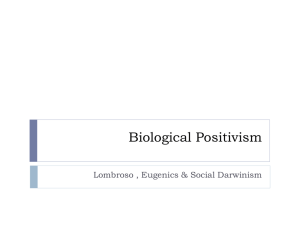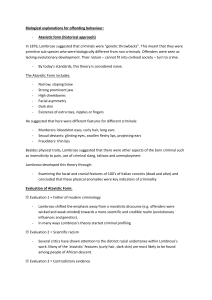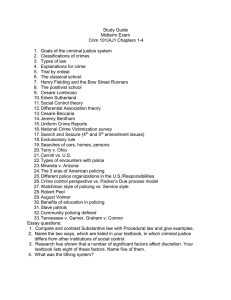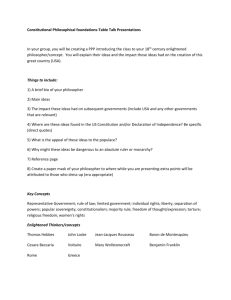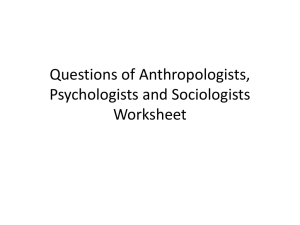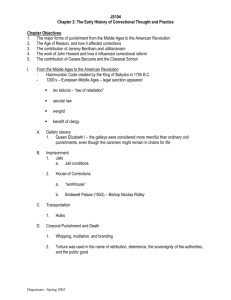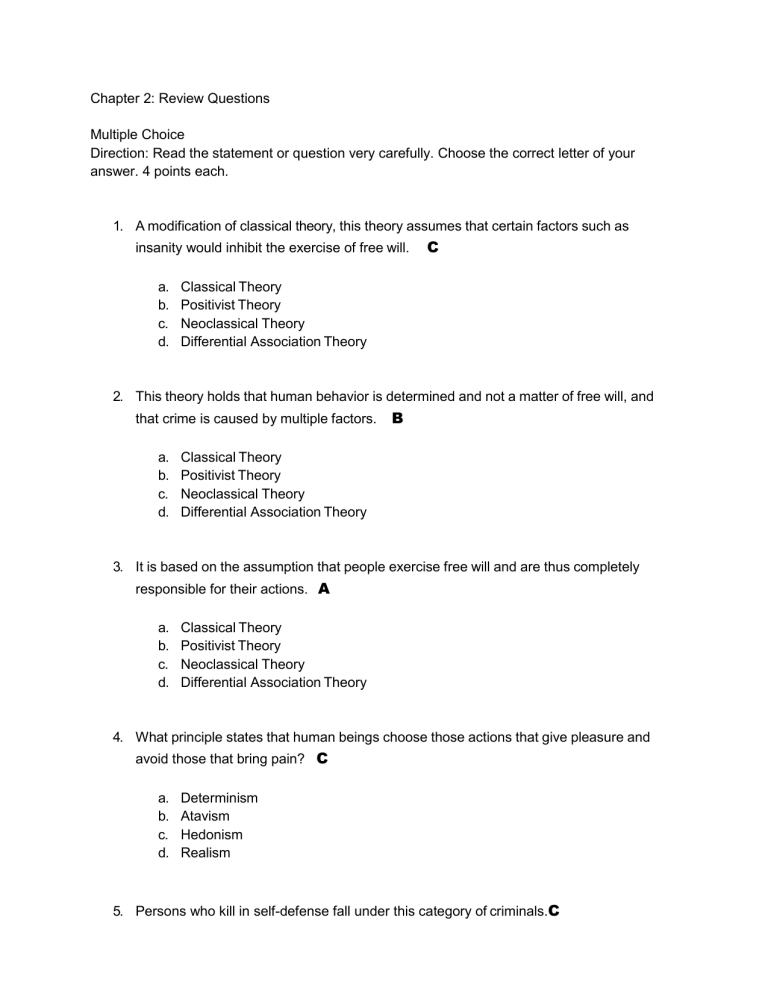
Chapter 2: Review Questions Multiple Choice Direction: Read the statement or question very carefully. Choose the correct letter of your answer. 4 points each. 1. A modification of classical theory, this theory assumes that certain factors such as insanity would inhibit the exercise of free will. a. b. c. d. C Classical Theory Positivist Theory Neoclassical Theory Differential Association Theory 2. This theory holds that human behavior is determined and not a matter of free will, and that crime is caused by multiple factors. a. b. c. d. B Classical Theory Positivist Theory Neoclassical Theory Differential Association Theory 3. It is based on the assumption that people exercise free will and are thus completely responsible for their actions. A a. b. c. d. Classical Theory Positivist Theory Neoclassical Theory Differential Association Theory 4. What principle states that human beings choose those actions that give pleasure and avoid those that bring pain? C a. b. c. d. Determinism Atavism Hedonism Realism 5. Persons who kill in self-defense fall under this category of criminals.C a. b. c. d. Passionate criminals Criminaloids Pseudo criminals Habitual criminals 6. The following are the basic elements of the Classical Theory, except: D a. In every society, people have free will to choose criminal or lawful solutions to meet their needs or settle their problems. b. Criminal solutions may be more attractive than lawful ones because the former usually require less work for a greater payoff. c. A person's choice for criminal solutions may be controlled by his fear of punishment. d. Criminals are fundamentally different from noncriminals. 7. His work was governed by the Utilitarian Theory, which assumes that all human actions are calculated in accordance with their likelihood of bringing happiness (pleasure) or unhappiness (pain). a. b. c. d. C Cesare Lombroso Cesare Beccaria Jeremy Bentham Enrico Ferri 8. He is considered today as the "Father of Modern Criminology." a. b. c. d. C Cesare Beccaria Auguste Comte Cesare Lombroso Enrico Ferri 9. He is regarded as the founder of the positivist school and sociology. a. b. c. d. Auguste Comte Cesare Lombroso Enrico Ferri Cesare Beccaria A 10. This criminologist believed that criminals could not be held morally responsible for their crimes because they did not choose to commit crimes but, rather, were driven to commit them by conditions in their lives. a. b. c. d. B Cesare Lombroso Enrico Ferri Raffaele Garofalo Auguste Comte 11. He suggested that death penalty could rid the society of its maladapted members, just as the natural selection process eliminated maladapted organism. a. b. c. d. C Cesare Lombroso Enrico Ferry Raffaele Garofalo Auguste Comte 12. This school of criminology worked on the relationship of crime statistics to demographic factors such as age, sex and race. a. b. c. d. C Neoclassical School Classical School Cartographic School Positivist School 13. He said that the crime problem could be traced, not to bad people, but to bad laws. B a. b. c. d. Cesare Lombroso Cesare Beccaria William Sheldon Charles Goring 14. They are individuals who are born with a genetic predilection towards criminality. B a. b. c. d. Atavistic individuals Born criminals Criminaloids Insane criminals 15. This theory asserts the criminals are a lower form of life, nearer to their apelike ancestors than non-criminals in traits in dispositions. a. b. c. d. C Classical Theory Anomie Theory Born Criminal Theory Moral Anomalies Theory 16. This theory was based on the opinion that criminals were developed from primitive or subhuman individuals characterized by some inferior and mental characteristics. a. b. c. d. D Anomie Theory Classical Theory Moral Anomalies Theory Atavism Theory 17. The following are Lombroso's major contributions to positivist criminology, except: C a. b. c. d. Theory of Atavism Application of the scientific method to study of criminal Death Penalty Development of a criminal typology 18. The following are the key assumptions of the positivist school of thought, except: a. b. c. d. Human behavior is determined and not a matter of free will. Criminals are fundamentally different from non-criminals. Crime is caused by a single factor. Society is based on consensus, and not on a social contract 19. They are called the "Holy Three" of Criminology. A a. b. c. d. Cesare Lombroso, Enrico Ferri, Raffaele Garofalo Cesare Beccaria, Jeremy Bentham, Cesare Lombroso Adolphe Quetelet, Andre Michel Guerry, Enrico Ferri Robert Ezra Park, Ernest Burgess, Raffaele Garofalo 20. They founded the so-called Cartographic School of Criminology.C C a. b. c. d. Cesare Lombroso, Enrico Ferri, Raffaele Garofalo Cesare Beccaria and Jeremy Bentham Adolphe Quetelet and Andre Michel Guerry Robert E. Park and Ernest Burgess 21. He believed that most criminals went through a process of training before finally becoming a criminal. a. b. c. d. B Emile Durkheim Gabriel Tarde Cesare Lombroso Adolphe Quetelet 22. According to him, crime results from a breakdown of social disorder as a result of loss of standards and values, a concept he called anomie. a. b. c. d. A Emile Durkheim Gabriel Tarde Clifford Shaw Adolphe Quetelet 23. This school of thought adopted a social ecology approach to studying cities, and postulated that urban neighborhoods with high levels of poverty often experience breakdown in the social structure and institutions such as family and schools. The result is social disorganization. a. b. c. d. C Classical School Positivist School Chicago School Lacassagne School 24. Which is a characteristic of positivist criminology? a. b. c. d. Death Penalty for some offenses Doctrine of Free Will Indeterminate sentence Anecdotal Method A 25. This school of thought in criminology rejected Lombroso's theory of "Criminal Type" and of "Born Criminals" by stressing the importance of social factors, but not rejecting biological factors. a. b. c. d. B Chicago School Lacassagne School Neoclassical School Cartographic School
